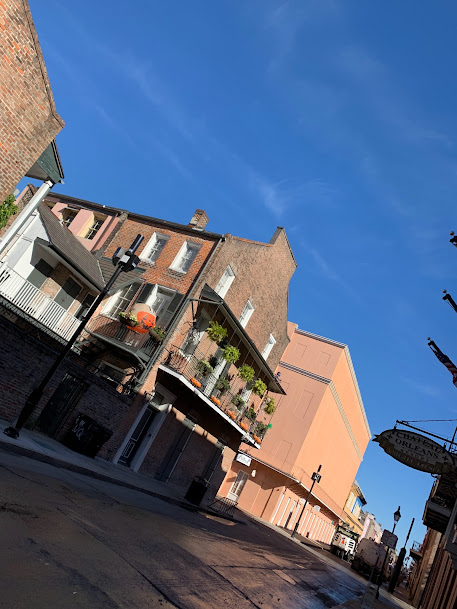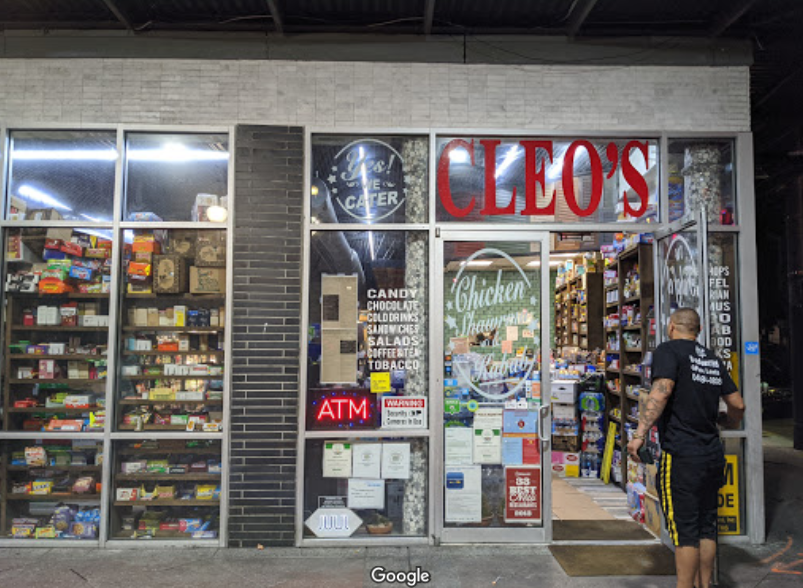Morning came to the sound of raucous laughter, Charlie Browning’ through paper thin walls, all wah-wah, full volume. 6:30 AM on a Thursday. Maybe it was still Wednesday night for that guy. Anyway, it could have been worse and I’d left all the exhaustion and weariness of the day before in the folds of those hostel sheets, so all was right with the world. While Mel was getting ready, I slipped down to the massive industrial kitchen in the common area and gathered up a free breakfast. The breakfast was… free. I housed a so-so bagel, slugged some burnt coffee and braved a biting wind as I cut a path for the French Quarter. Two blocks away, I realized that the area around our hostel was not the place to be if you were looking for ambience. Imagine ‘The Strip’ in Vegas. There was a Hustler Hollywood. I’d been a little disappointed on our walk from the train station. I’d been expecting architecture, history, a little magic.
The French Quarter delivered.


I walked a jagged line East through that neighborhood, gawking at the wrought iron railings on the balconies, the ferns growing full and hungry, hanging from porticos. The sound of Jazz, the smell of frying food. I finally found myself at the Mississippi, wandered its banks eastward with my jaw flapping in that icy wind. Surging, coffee-two-creams colored water, coursing along the New Orleans cityscape. To the west, a staggeringly large bridge spanned that coiled python of a waterway, connecting this side of Louisiana to that. Cruise ships were moored along the waterfront beside it. They passed beneath it with ease. Not two-story river cruises. Big, Carnival-looking, shrimp cocktails and waterslides cruise ships. Truly massive tankers Tokyo-drifted the bend in the river, carrying a city-blocks worth of cargo on their mighty backs.

The wind was furious as I made my way along the water’s edge. Arctic blasts of it came ripping down out of the clear blue sky to slash whitecaps on the water and put tears in my eyes and I pushed through it with my fists mashed into the pockets of my coat. All around me, the sound of music intertwining with the grinding roar of a city. Classic rock, jazz, bubbling up through the drone of jackhammers and weed whackers. The air smelled faintly of the sea. Not always. Often, the smell of car exhaust and occasionally the reek of sewer, but sometimes, when the wind was right, salt and foam, kelp and coral. I meandered to the edge of the wharf, then through the French Market. It was bustling, but nothing like it would be on the weekend. People selling gator nuggets, trinkets, voodoo memorabilia. I’d struck out that morning with my sights set on finding a park I’d read about when I was bloodhounding through the New Orleans chat boards, and I could see my little blue dot drifting closer and closer on Google Maps, but I was struggling to actual find it until I saw the 12 foot letters printed on what looked like a sea-wall. CRESCENT PARK.

I followed a sidewalk splashed with encouraging messages in spraypaint (“Focus”, “Keep Going”, “Don’t give up now”) to an epic, rusted, staircase which, I was delighted to discover, was the entrance to the park. The staircase, a spiky piece of urban art, rose sharply up from the sidewalk, stretched out over the railroad tracks and dropped down, down, into what had once been a warehouse space.They’d knocked the walls down to let the river breezes in, painted looping, concentric circles on the floor, but left sheet metal roof to provide shelter from the heavy rains, the sultry southern sun. As I made my way down the staircase, a man was rollerskating in lazy ellipses across that open space. A little girl was exploring the edges on a Huffy.

At the termination of the roof the park continued into a row of swinging benches, and behind those, a sprawling lawn of crabgrass and clover. A homeless man lay sleeping in that marshy grass beside a golden retriever and they looked so goddamn peaceful that I almost joined them. A walking trail snaked its way out of the eastern edge of the park and I followed it, the river rolling along to my right, warehouses looming to my left. A beautiful love story played out there along that trail. Someone had painted the words “YOU ARE BEAUTIFUL” on the roof of one of those warehouses in white paint.

As I read that, my attention naturally drifted back to the river, that cooing, gurgling thing, where I saw a sheet of plywood propped up on the shattered pilings rising up out of the water. The words “I love you” were spelled out in bricks on that plywood and it was as though the city and the river were having a moment that I’d just interrupted with my wandering.

The trail led to a rusted metal pier that was kissed with graffiti. It looked like another abandoned thing, left to the whirling mash of the tide. But as I approached it, there was a sneaky little bridge and when I crossed it, I found myself in yet another park. It wasn’t fancy, but it was a quiet, open space, which is a luxury in any city. There was a peephole in the center of it, a cutout with a railing that probably held a pillar at one point. Now the river went rushing underneath it, gurgling melodically. They could have just banged that whole place down to make room for expensive apartments. They would have, in another city. Here, it gave back.

I continued my eastward press through that space and found yet another piece of New Orleans magic, buried in that marshy riverside. The Rusty Rainbow bridge spanned a bog dividing the trail from the Bywater neighborhood. A 75-foot long hunk of artfully corroded steel with precipitous steps on either side. It would be the highlight of your jog if you crossed it everyday. Probably kick your ass a little bit, but in a fun way, like a jiu jitsu class. It deposited me into the Bywater neighborhood, which was delightful. A crayon box of houses, every building a kaleidoscope of pastel colors, and on every flat surface, art. Art about inequity, diversity, change, love. It was striking and galvanizing and good, like exhaling a breathe that I didn’t know I’d been holding. Like slipping into warm water when there’s a chill in the air. I didn’t often feel that way in Georgia. I didn’t see openness and acceptance on the tip of a brush, shining like a lantern above a door so that when you see it, you know that you are safe here. I had starred only one place in that neighborhood and I found myself standing at its door with the smell of fresh bread in my sinuses and a line of drool down my chin.

The Bywater Bakery. Jesus Christ this place. It’s a brilliant red building flanked by little tables, bustling with happy people who are in the process of filling themselves with fresh-baked-bang-bang. The staff greeted everyone they encountered, myself included, like a regular or a direct relative or an organ donor. I ordered a fancy egg-in-toast, (a quail egg embedded in the center of freshly baked garlic bread) and a sweet potato sticky bun for Melissa. Then I carried my little box of pirate booty out onto that windswept street, with my heart set on slaying it outright with warm bread and golden yolk. It was glorious. Rich and sparkly and deep. With that in my furnace, I turned on a heel and began my journey back to our hostel. At some point along that mystical waterfront the wind snapped off like it was wired to a breaker.
HOT.
That southern sun without the chaser of wind to stunt it beamed down on me and I had to peel my jacket off my back, stuff it in my day pack. I was shimmering with sweat when I finally found my way back to the hostel. Found Mel in the lobby working and I offered her her baked good like a cat offers a dead bird to the woman who feeds it.
After a few minutes of rest in the hostel lobby, the city beckoned me again and I slipped back out into its wilds for lunch. Killer Po-boy was planted just over the demarcation line between the French Quarter and the Central Business District. Casual sandwich joint serving street legal drugs in the form of life-changing sandwiches. I ordered a pork belly for myself because the woman behind the counter called it ‘magic’ and I respect magic. I picked up a tofu po-boy for mel, shimmied back to the hostel with a bag of boom-boom. Magic indeed. The slaw was a revelation, bright and lemony and perfectly balanced against the sweet, smokey bite of the pork belly. A dove flew out of my hat when I was done with it.

That night brought us to the Sylvain, bellied up to the bar with Sazerac’s clenched in our fists. That night brought us a fledgling peeler fire and a chance encounter with a bastion of New Orleans mystery. That night brought us the Woojie List. But long before that, somewhere between Crescent Park and the Bywater Bakery, my heart was open. Open to the gravity that city. Open to the possibility of goodness etched into the foundation of a place. Open to magic.










